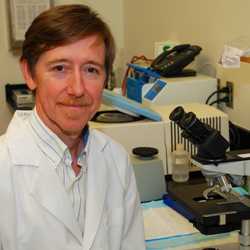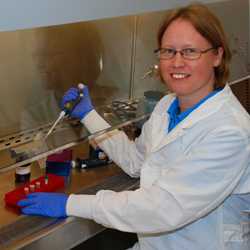AMD Projects: Detecting Intestinal Diseases
Advancing detection of cyclosporiasis (C. cayetanensis) using genomics-based laboratory surveillance and reference diagnostics

Cyclosporiasis is a foodborne illness. CDC recommends safe food handling techniques for preparing fresh fruits and vegetables
Since the 1990s, CDC has conducted several large, multi-state outbreak investigations in which food items were found to be potential sources of the parasite Cyclospora cayetanensis. The multi-state outbreak of cyclosporiasis during the summer of 2013 was one of the largest and most complex cyclosporiasis outbreak investigations conducted in the United States. CDC and state officials investigated 631 cases, with 49 hospitalizations, in 25 states. The majority of the cases were reported from Iowa, Nebraska, and Texas. Overall, the majority of cases nationwide could not be linked to a specific food source.
About 2 months after the investigation began it became clear that the cases were not all part of the same outbreak. Federal and state scientists suspected more than one source of infection. Investigators could have reached this conclusion faster if they had laboratory tools that could tell whether different strains of the parasite were present and help determine if cases were linked to each other.
To improve outbreak response and surveillance, CDC must gather data on the genetic diversity of this parasite. CDC will do this by sequencing the DNA of samples of the parasite that circulate in the US and different parts of the world. CDC also will analyze the DNA of parasites collected from individual outbreak-related cases—as well as cases not known to be linked to an outbreak—to identify potential genotyping markers and develop a new DNA-based surveillance system for cyclosporiasis.
2017 Project Update
Before the AMD program began in 2014, no genomic sequences of Cyclospora cayetanensis were available. To diagnose C. cayetanensis as the cause of someone’s illness, laboratory scientists had to identify the parasite in a person’s stool sample. But these outbreaks often went unsolved because we had no way of comparing the strain of C. cayetanensis that infected a person with a strain of C. cayetanensis found in a food source.
Using AMD methods, CDC scientists, along with colleagues from the U.S. Food and Drug Administration (FDA), state public health departments, and academic institutions, have developed the first ever process to acquire genomic sequences from C. cayetanensis. The complex process involves obtaining a pure sample of C. cayetanensis from human stool samples, breaking open the parasite’s extremely strong outer wall, extracting the small amount of genetic material available, sequencing that genetic material, and then analyzing the genomic data to allow comparison of various strains. Through this work, CDC has obtained genomic sequences from 19 samples. In collaboration with colleagues at the FDA, they are addressing the challenge of developing tools that reliably compare and match genomic data from parasites found in food to those found in human stool samples. In 2017, investigators will continue evaluating potential genetic markers for identifying various genotypes of C. cayetanensis and improving detection of the parasite in humans and food sources. This work will help us develop a laboratory-based surveillance system for cyclosporiasis that will identify and help us stop outbreaks faster.
PRINCIPAL INVESTIGATOR PROFILE
Michael J. Arrowood, MS, PhD
Microbiologist
Waterborne Disease Prevention Branch
Division of Foodborne, Waterborne, and Environmental Diseases
National Center for Emerging and Zoonotic Infectious Diseases

Michael Arrowood, MS, PhD is a microbiologist in the Waterborne Disease Prevention Branch of CDC’s National Center for Emerging and Zoonotic Infectious Diseases. Since joining CDC in 1991, his primary area of focus has been on intracellular protozoan parasites that cause diarrhea, including species of Cryptosporidium and Cyclospora. During his career, he has developed standardized methods for the production and purification of these parasites from experimentally-infected animals and naturally-infected humans, developed monoclonal antibody-based diagnostic assays for cryptosporidial oocysts in stool and water samples, and developed in vitro cultivation methods for C. parvum. In addition, he has developed diagnostic assays and culture models suitable for drug testing and evaluating disinfection strategies. Dr. Arrowood has authored or co-authored nearly 100 articles for peer-reviewed journals and 10 book chapters.
PRINCIPAL INVESTIGATOR PROFILE
Yvonne Qvarnstrom, PhD
Senior Service Fellow
Parasitic Diseases Branch
Division of Parasitic Diseases and Malaria
Center for Global Health

Yvonne Qvarnstrom, PhD, is a senior service fellow in the reference diagnostic laboratory in the Division of Parasitic Diseases and Malaria in CDC’s Center for Global Health. She develops new diagnostic methods and conducts research in diagnostic parasitology. She received her Master of Science in clinical microbiology from Griffith University in Australia and her doctorate in medical sciences from Uppsala University in Sweden. She has published over 30 scientific articles in peer-reviewed journals and has presented her work at numerous national and international conferences.
- Page last reviewed: March 27, 2017
- Page last updated: March 27, 2017
- Content source:


 ShareCompartir
ShareCompartir